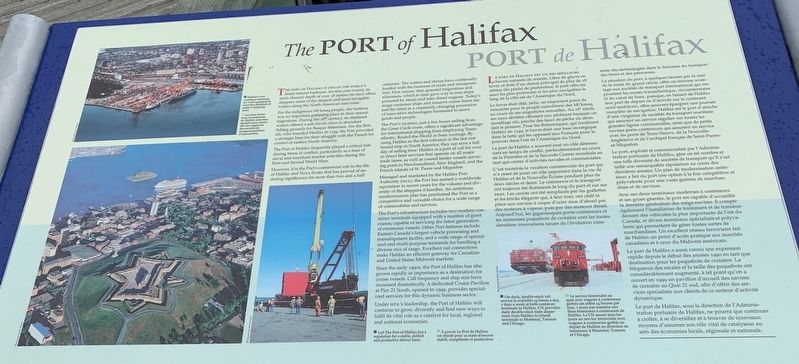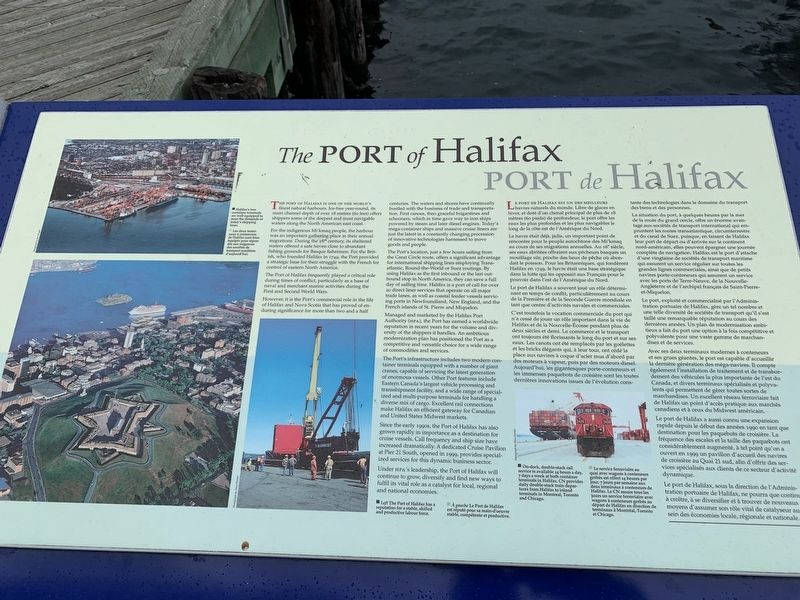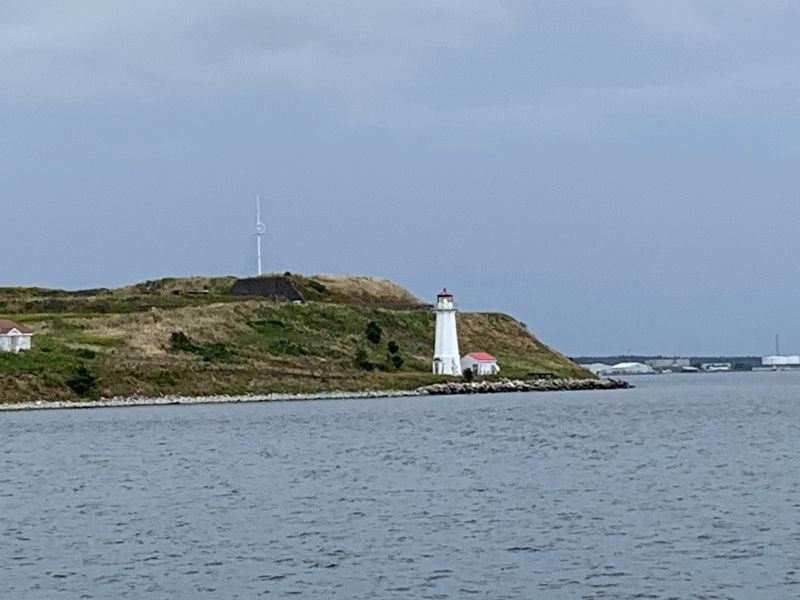Halifax in Halifax Region, Nova Scotia — The Atlantic Provinces (North America)
Port of Halifax/Port de Halifax
English: The Port of Halifax is one of the world’s finest natural harbours. Ice-free year-round, its main channel depth of over 18 metres (60 feet) offers shippers some of the deepest and most navigable waters along the North American east coast.
For the indigenous Mi'kmaq people, the harbour was an important gathering place in their annual migrations. During the 16th century, its sheltered waters offered a safe haven close to abundant fishing grounds for Basque fishermen. For the British, who founded Halifax in 1749, the Port provided a strategic base for their struggle with the French for control of eastern North America.
The Port of Halifax frequently played a critical role during times of conflict, particularly as a base of naval and merchant marine activities during the First and Second World Wars
However, it is the Port's commercial role in the life of Halifax and Nova Scotia that has proved of enduring significance for more than two centuries. The waters and shores have continually bustled with the business of trade and transportation. First canoes, then graceful brigantines and schooners, which in time gave way to iron ships powered by steam and later diesel engines. Today's mega-container ships and massive cruise liners are just the latest in a constantly changing procession of innovative technologies harnessed to move goods and people.
The Port's location, just a few hours sailing from the Great Circle route, offers a significant advantage for international shipping lines employing Transatlantic, Round-the-World or Suez routings. By using Halifax as the first inbound or the last out-bound stop in North America, they can save a fuli day of sailing time. Halifax is a port of call for over 20 direct liner services that operate on all major trade lanes, as well as coastal feeder vessels servicing ports in Newfoundland, New England, and the French islands of St. Pierre and Miquelon.
Managed and marketed by the Halifax Port Authority (HPA), the Port has earned a worldwide reputation in recent years for the volume and diversity of the shippers it handles. An ambitious modernization plan has positioned the Port as a competitive and versatile choice for a wide range of commodities and services.
The Port's infrastructure includes two modern container terminals equipped with a number of giant cranes, capable of servicing the latest generation of enormous vessels. Other Port features include Eastern Canada's largest vehicle processing and transshipment facility, and a wide range of specialized and multi-purpose terminals for handling a diverse mix of cargo. Excellent rail connections make Halifax an efficient gateway for Canadian and United States Midwest markets.
Since the early 1990s, the Port of Halifax has also grown rapidly in importance as a destination for cruise vessels. Call frequency and ship size have increased dramatically. A dedicated Cruise Pavilion at Pier 21 South, opened in 1999, provides specialized services for this dynamic business sector.
Under HPA's leadership, the Port of Halifax will continue to grow, diversify and find new ways to fulfil its vital role as a catalyst for local, regional and national economies.
Le harve etait, jadis, un important point de rencontre pour le peuple autochtone des Mi'kmaq au cours de ses migrations annuelles. Au 16° siècle ses eaux abritées offraient aux pêcheurs basques un mouillage sûr, proche des lieux de pêche où abondait le poisson. Pour les Britanniques, qui fondèrent Halifax en 1749, le havre était une base stratégique dans la lutte qui les opposait aux Français pour le pouvoir dans l'est de l'Amérique du Nord.
Le port de Halifax a souvent joué un rôle déterminant en temps de conflit, particulièrement au cours de la Première et de la Seconde Guerre mondiale en tant que centre d’activities navales et commerciales.
C'est toutefois la vocation commerciale du port qui n'a cessé de jouer un rôle important dans la vie de Halifax et de la Nouvelle-Écosse pendant plus de deux siècles et demi. Le commerce et le transport ont toujours été florissants le long du port et sur ses eaux. Les canots ont été remplacés par les goélettes et les bricks élégants qui, à leur tour, ont cédé la place aux navires à coque d'acier mus d'abord par des moteurs à vapeur, puis par des moteurs diesel. Aujourd 'hui, les gigantesques porte-conteneurs et les immenses paquebots de croisière sont les toutes dernières innovations issues de l'évolution constant des technologies dans le domanine du transport des biens et des personnes.
La situation du port, à quelques heures par la mer de la route du grand cercle, offre un énorme avantage aux sociétés de transport international qui empruntent les routes transatlantique, circumterrestre et du canal de Suez, puisque, en faisant de Halifax leur port de départ ou d'arrivée sur le continent nord-américain, elles peuvent épargner une journée complète de navigation. Halifax est le port d'attache d'une vingtaine de sociétés de transport maritime qui assurent un service régulier sur toutes les grandes lignes commerciales, ainsi que de petits navires porte-conteneurs qui assurent un service avec les ports de Terre-Neuve, de la Nouvelle- Angleterre et de l'archipel français de Saint-Pierre- et-Miquelon.
Le port, exploité et commercialisé par l'Administration portuaire de Halifax, gère un tel nombre et une telle diversité de sociétés de trasport qu'il s'est taillé une remarquable réputation au cours des dernières années. Un plan de modernisation ambitieux a fait du port une option à la fois compétitive et polyvalente pour une vaste gamme de marchandises et de services.
Avec ses deux terminaux modernes à conteneurs et ses grues géantes, le port est capable d'accueillir la dernière génération des méga-navires. Il compte également l'installation de traitement et de transbor- dement des véhicules la plus importante de l'est du Canada, et divers terminaux spécialisés et polyva- lents qui permettent de gérer toutes sortes de marchandises. Un excellent réseau ferroviaire fait de Halifax un point d'accès pratique aux marchés canadiens et à ceux du Midwest américain.
Le port de Halifax a aussi connu une expansion rapide depuis le début des années 1990 en tant que destination pour les paquebots de croisière. La fréquence des escales et la taille des paquebots ont considérablement augmenté, à tel point qu'on a ouvert en 1999 un pavillon d'accueil des navires de croisière au Quai 21 sud, afin d'offrir des services spécialisés aux clients de ce secteur d'activité dynamique.
Le port de Halifax, sous la direction de l'Administration portuaire de Halifax, ne pourra que continuer à croître, à se diversifier et à trouver de nouveaux moyens d'assumer son rôle vital de catalyseur au sein des économies locale, régionale et nationale.
Photos:
Halifax's two container terminals are well equipped to meet the demands of today's shipping lines./ Les deux terminaux à conteneurs de Halifax sont bien équipés pour répondre aux exigences des sociétés de transport maritime d'aujourd'hui.
The Port of Halifax has a reputation for a stable, skilled and productive labour force./ A gauche Le Port de Halifax est réputé pour sa main-d'oeuvre stable, compétente et productive.
On-dock, double-stack, rail service is available 24 hours a day, 7 days a week at both container terminals in Halifax. CN provides daily train departures from Halifax to inland terminals in Montreal, Toronto, and Chicago./Le service ferroviaire à quai, à double étage, est disponible 24h / 24, 7 jours par semaine aux deux terminaux à conteneurs à Halifax. Le CN offre des départs quotidiens en train entre Halifax, Toronto, Toronto et Chicago.
Topics. This historical marker is listed in these topic lists: Industry & Commerce • Waterways & Vessels. A significant historical year for this entry is 1749.
Location. 44° 38.505′ N, 63° 33.998′ W. Marker is in Halifax, Nova Scotia, in Halifax Region. Marker can be reached from Lower Water Street. Touch for map. Marker is in this post office area: Halifax NS B3H 4PH, Canada. Touch for directions.
Other nearby markers. At least 8 other markers are within walking distance of this marker. Ships and Men of the Royal Canadian Navy (within shouting distance of this marker); The Volunteers (within shouting distance of this marker); Ocean Terminals/le terminal ocean terminals (within shouting distance of this marker); Samuel Cunard (within shouting distance of this marker); Prince Valiant (about 120 meters away, measured in a direct line); The Tall Ships Parade 2000 (about 150 meters away); The Grand Dérangement (about 180 meters away); Charles Morris (approx. 0.3 kilometers away). Touch for a list and map of all markers in Halifax.
Also see . . .
1. Port of Halifax. (Submitted on September 24, 2019, by Steve Stoessel of Niskayuna, New York.)
2. Port of Halifax (Wikipedia). (Submitted on September 24, 2019, by Steve Stoessel of Niskayuna, New York.)
Credits. This page was last revised on September 28, 2019. It was originally submitted on September 24, 2019, by Steve Stoessel of Niskayuna, New York. This page has been viewed 159 times since then and 16 times this year. Photos: 1, 2, 3. submitted on September 24, 2019, by Steve Stoessel of Niskayuna, New York. • Andrew Ruppenstein was the editor who published this page.


